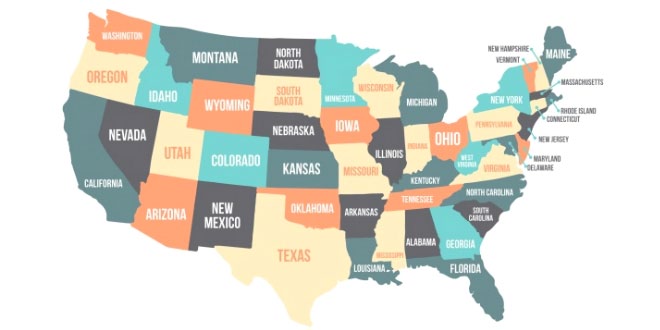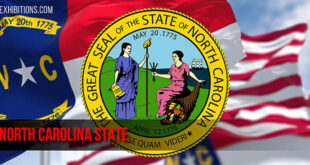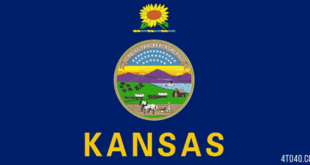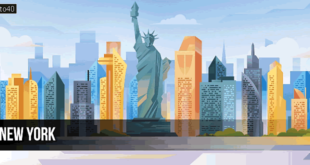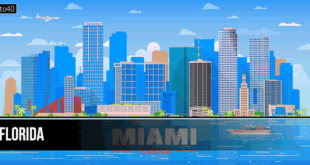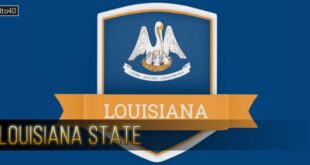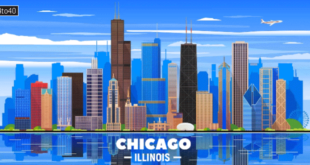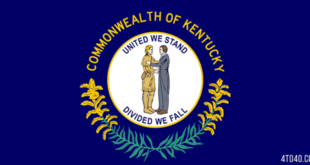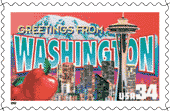 Encompassing 184,674 sq km (71,303 sq mi), Washington ranks 18th among the states in land area and, with 4,866,692 inhabitants (1990 census), 18th in population. The population is increasing at a greater rate than the national average.
Encompassing 184,674 sq km (71,303 sq mi), Washington ranks 18th among the states in land area and, with 4,866,692 inhabitants (1990 census), 18th in population. The population is increasing at a greater rate than the national average.
Thousands of years of occupancy by American Indians were interrupted during the late 18th century by the arrival of European and American explorers and traders. The ensuing fur trade gave way to permanent white settlement during the 1840s. Washington, with its capital at OLYMPIA, became a territory in 1853 and in 1889 became the 42d state. Long noted for its abundant natural resources of water, timber, and fish, today Washington State is a leader in the aerospace industry, international trade, and tourism.
Washington State: Land & Resources
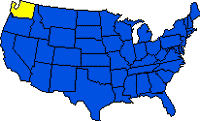 Washington is characterized by greatly varying relief and scenery. Although the rough outline of Washington’s coast totals only 253 km (157 mi), the actual coastline is 4,870 km (3,026 mi) because of the many inlets and small islands in PUGET SOUND. The Strait of JUAN DE FUCA and the adjoining Puget Sound and Strait of Georgia separate the Olympic Mountains (highest peak, Mount Olympus, at 2,428 m/7,965 ft) on the Olympic Peninsula from British Columbia’s Vancouver Island. To the east and southeast of the sound is a coastal plain, the Puget Sound lowland. To the east the lowland gives way to the CASCADE RANGE (highest peak, Mount Rainier, at 4,392 m/14,410 ft). Scarred and sculpted by glaciers and ice sheets, the Cascades are dominated by dormant volcanoes, in addition to Mount Rainier (including Adams, Baker, and Glacier). Another volcano in the Cascades, Mount St. Helens–dormant since 1857–erupted in 1980, causing extensive damage mostly from volcanic ash. To the far east lie the lower slopes of the ROCKY MOUNTAINS. In the north are the Okanogan Highlands. Enclosed by the mountains (except in the southeast) lies the roughly triangular-shaped Columbia Basin, which incorporates incised coulees, lava plateaus, and undulating hills. The Columbia Basin and the Puget Sound lowland constitute Washington’s only extensive level areas.
Washington is characterized by greatly varying relief and scenery. Although the rough outline of Washington’s coast totals only 253 km (157 mi), the actual coastline is 4,870 km (3,026 mi) because of the many inlets and small islands in PUGET SOUND. The Strait of JUAN DE FUCA and the adjoining Puget Sound and Strait of Georgia separate the Olympic Mountains (highest peak, Mount Olympus, at 2,428 m/7,965 ft) on the Olympic Peninsula from British Columbia’s Vancouver Island. To the east and southeast of the sound is a coastal plain, the Puget Sound lowland. To the east the lowland gives way to the CASCADE RANGE (highest peak, Mount Rainier, at 4,392 m/14,410 ft). Scarred and sculpted by glaciers and ice sheets, the Cascades are dominated by dormant volcanoes, in addition to Mount Rainier (including Adams, Baker, and Glacier). Another volcano in the Cascades, Mount St. Helens–dormant since 1857–erupted in 1980, causing extensive damage mostly from volcanic ash. To the far east lie the lower slopes of the ROCKY MOUNTAINS. In the north are the Okanogan Highlands. Enclosed by the mountains (except in the southeast) lies the roughly triangular-shaped Columbia Basin, which incorporates incised coulees, lava plateaus, and undulating hills. The Columbia Basin and the Puget Sound lowland constitute Washington’s only extensive level areas.
Climate
Under the influence of prevailing westerly winds and the rain-shadow effect of the Cascades, Washington is divided into two major climatic regions: a moist, temperate zone to the west with approximately 500 to 3,800 mm (20 to 150 in) of precipitation and an annual temperature fluctuation of 8 to 11 C degrees (14 to 20 F degrees), and a drier, somewhat continental eastern region with 200 to 635 mm (8 to 25 in) of precipitation and a temperature range of 25 deg to 28 deg C (45 deg to 50 deg F). Summer is the dry season throughout almost the entire state, and cyclonic storms from the west constitute the most frequent and regular meteorological disturbances.
Tourism
With much of its total area available for recreational purposes, Washington has become a major tourist state in recent decades. Three national parks (Olympic, Mount Rainier, North Cascades), several national forests (including Mount Baker-Snoqualmie, Gifford Pinchot, and Olympic), and various wilderness and national recreational areas, together with more than 150 state and county parks, provide opportunities in every part of the state for year-round recreation, including winter sports, mountaineering, backpacking, and water sports. Private resort areas, especially in the mountains and close to rivers and lakes, supplement the public lands. They include ski resorts, marinas, beach resorts, dude ranches, hunting lodges and fishing camps.
Washington State: History
American Indians have inhabited Washington for more than 10,000 years and developed life-styles that remained little changed until the arrival of European explorers 2 centuries ago. Archaeological evidence found at Marmes Cave, North Bonneville, and elsewhere have provided significant archaeological evidence. The settled Coast Salish bands of western Washington–including the CHINOOK, NISQUALLY, and PUYALLUP–lived in cedar lodges, had salmon and shellfish as their staples, and developed elaborate POTLATCH ceremonies. The plateau Indians of the interior–including the NEZ PERCE, OKANOGAN, SPOKAN, and YAKIMA–were nomadic hunters who eventually lived in skin tepees and depended on the horse for their peripatetic life-style.
Exploration and Confrontation
Early contacts between Indians and Europeans were abrupt and often brutal, and the consequences for the Indians were serious. Smallpox, cholera, and measles severely reduced the tribes’ population, and subsequent white settlement led to loss of Indian lands and the establishment of reservations.
Coastal exploration by the Spanish began during the 16th century. The first landing was made in 1775, by Bruno Heceta and Juan Francisco de la Bodega y Quadra, near Point Grenville, to forestall Russian expansion southward from Alaska. The English captain James Cook sailed along the coast in 1778, and the American captain Robert GRAY discovered the Columbia River in 1792. The same year, Capt. George VANCOUVER completed the first mapping of the entire coastline. Overland exploration, initiated by the LEWIS AND CLARK EXPEDITION in 1805-06, was completed within a decade by David THOMPSON and various fur traders.
The Fur Trade and White Settlement
The fur trade constituted Washington’s first major industry. A sea-otter trade begun in 1790 was superseded by a land-based fur trade in 1811. Two companies, John Jacob Astor’s Pacific Fur Company–a subsidiary of his AMERICAN FUR COMPANY–and the Montreal-based NORTH WEST COMPANY, competed for the furs. Economic success came only with the HUDSON’s BAY COMPANY’s takeover in 1821. Under the direction of Dr. John MCLOUGHLIN, Fort Vancouver became the headquarters of operations that ranged from California to Alaska. A subsidiary, the Puget Sound Agricultural Company, provided food for subsistence. In addition to furs, some agricultural products, dried salmon, and sawed timber were exported.
An influx of American missionaries, led by Marcus WHITMAN and Jason Lee, into the Oregon country during the 1830s was followed in the next decade by the first rush–5,000 strong–of American settlers, and the competing British and U.S. claims quickly came to a climax. British preference for the Columbia River and America’s political slogan of “Fifty-four forty or fight!” (referring to the latitude 54 deg 40′) gave way to compromise, however, when, in 1846, the 49th parallel was chosen as the boundary between Canada and the United States.
Through the 1850s, Oregon’s Willamette River valley drew most of the Northwest’s new settlers. In eastern Washington, the Whitman massacre at Waiilatpu in 1847 was followed by protracted Indian wars that lasted throughout the next decade and delayed occupation of the Columbia Basin. Meanwhile, settlements were established around Puget Sound–Olympia in 1846, Seattle and Port Townsend in 1851, and Whatcom (later Bellingham) in 1852.
Economic Growth and Statehood
A proposal for a Columbia Territory was passed by Congress in March 1853, with the name Washington being substituted by amendment. Isaac I. Stevens became the first territorial governor, and during the next few years treaties were signed between the United States and the Indian tribes, notably the Treaty of Point Eliot (1856). The Donation Act enabled settlers to file claims up to 320 acres (130 ha) for a single person or 640 acres (260 ha) for a married couple. By the early 1860s most accessible land was owned and occupied.
Development was slow during the 1850s, but by 1860 the white population numbered 12,000. During the next three decades lumbering operations proliferated along Puget Sound. Coal and gold were discovered and mined, salmon canning begun, the Palouse River valley occupied and the so-called inland wheat empire established, irrigation of parts of the Columbia Basin attempted, and railroad lines built, notably the Northern Pacific and the Great Northern. By 1880 the population exceeded 75,000, and by 1890 it had reached 357,000. Seattle, Spokane, and Tacoma had emerged as major urban centers. In 1889, Washington became the 42d state. Elisha Ferry was elected as the first governor.
20th Century
The 1893 depression was a major setback to growth, but by 1900 the state once again was making rapid progress, politically and socially as well as economically. This was especially marked during the so-called Progressive Era. Establishment of regulatory agencies, legislation by referendum, and female suffrage were its major achievements.
The Depression years of the 1930s saw the inauguration of the Columbia Basin Project and the Bonneville Power Administration, to build dams and provide hydroelectric power. During the 1940s, Boeing emerged as a major international company, and manufacturing other than processing of local resources, finance, and tourism began to assume major roles. World War II and the wars in Korea and Vietnam provided further economic incentives. After downturns in the early 1970s and again in the early 1980s, the economy rebounded dramatically with an infusion of high-tech companies and expanding trade with Pacific nations.
Washington State: Land
- Area: 184,674 sq km (71,303 sq mi); rank: 18th.
- Capital: Olympia (1990 pop., 33,840).
- Largest city: Seattle (1990 pop., 516,259).
- Counties: 39.
- Elevations: highest–4,392 m (14,410 ft), at Mount Rainier; lowest–sea level, at the Pacific coast.
Washington State: Symbols
Flag:

Statehood:
Nov. 11, 1889; the 42nd state
Nickname:
Evergreen State
Bird:
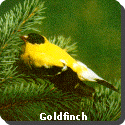
Tree:
Western Hemlock
Flower:
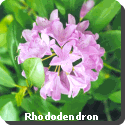
Motto:
Alki (“By and By”)
Song:
“Washington, My Home.”
 Kids Portal For Parents India Kids Network
Kids Portal For Parents India Kids Network
